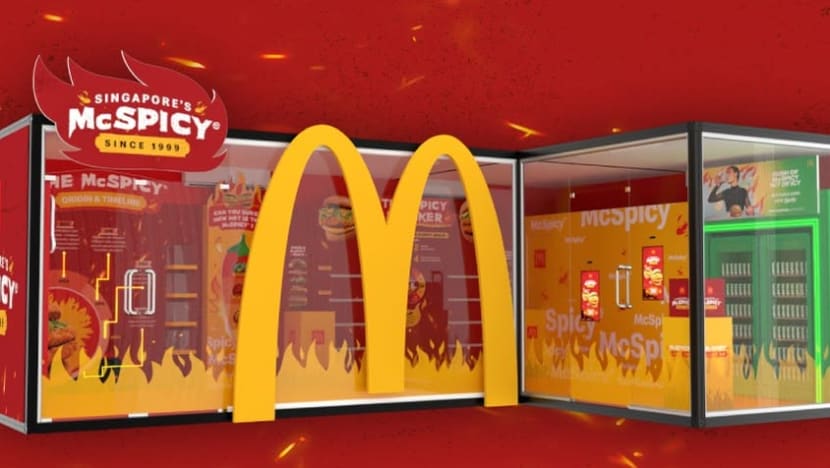Commentary: Now that the McSpicy Museum is over, what was that all about?
Our reverence for the McSpicy lies in the convenience, nostalgia and its role as a cultural symbol, says food writer Pamelia Chia.


This audio is generated by an AI tool.
BREDA, The Netherlands: More than 25 years ago, McDonald’s introduced the McSpicy burger to Singapore - chicken thigh marinated in a spicy seasoning, breaded, deep-fried, and served on a sesame seed bun with shredded lettuce and mayonnaise.
With an intense burn designed to suit the local palate, the McSpicy quickly became so popular that it remains a staple on the fast food chain’s menu to this day.
Over the last two weeks, McDonald’s celebrated the burger’s journey from inception to local icon. The McSpicy Museum, a pop-up event held from May 13 to May 25, transformed the open area next to McDonald’s at Bugis Junction into an interactive space featuring reflex-testing games, trivia, photo booths and vibrant installations.
As a Singaporean currently residing in Europe, I’ve noticed a stark contrast in attitudes towards fast food. Europeans often view fast food as low-status or unhealthy, associating it with rushed lifestyles or the working class. In contrast, fast food in Singapore is far from stigmatised.
In fact, there are now more than 700 fast food establishments across the country, with two fast food giants - South Korea’s Lotteria and America’s Chick-fil-A - entering the market this year.
Even as Singaporeans become more health-conscious, our enduring, enthusiastic embrace of fast food makes me wonder: What does this deep affection mean for us, and what does it say about our society?
CONVENIENCE CULTURE
A quick search on online forums suggests a straightforward answer: Pragmatism.
In a fast-paced urban environment like Singapore, convenience and value are key decision drivers. With only 22 per cent of Singaporeans cooking at home daily, fast food chains meet a critical demand for quick, reliable meals amid busy schedules.
Conveniently located in malls and near MRT stations, fast food outlets deliver speed, order, and reliability - qualities highly prized by time-pressed, energy-sapped office workers and students.
While local hawker stalls provide some of the country’s cheapest meals, they often close on certain days or have limited hours. Fast food chains, by contrast, are almost always open for business, with some operating 24 hours a day, 365 days a year.
With rising hawker prices, fast food may appeal to budget-conscious Singaporeans who desire air-conditioned comfort in the island’s oppressive heat and humidity.
To sweeten the deal, many chains also offer loyalty programmes that reward repeat customers with points redeemable for food or discounts, further increasing their value-for-money appeal.
FAST FOOD AS CULTURAL SYMBOL
Nostalgia also plays an important role in why fast food is so dear to the hearts of so many Singaporeans.
Prior to the late 1970s, when McDonald’s first arrived in Singapore, locals mostly ate at hawker centres and traditional eateries.
The arrival of modern, clean, American, air-conditioned fast food chains introduced a new dining trend and symbolised a connection to Western culture and global modernity.
While Europeans saw fast food more as a convenient or cheap alternative, Singaporeans saw it as aspirational or symbolically celebratory, as the arrival of fast food coincided with Singapore’s rapid modernisation.
What’s now an ordinary burger was once seen as an “atas” (upscale) treat then - a special indulgence beyond typical hawker fare.
An entire generation of millennial children grew up perceiving birthday celebrations at McDonald’s or Happy Meals - kid-sized meal sets that include small toys - as luxurious treats.
In 2000, McDonald’s Singapore launched a campaign where customers were able to purchase limited-edition Hello Kitty plushies with every Extra Value Meal. The toys sparked nationwide frenzy, with up to 300,000 people lining up at outlets island-wide and culminating in skirmishes and other public disturbances.
This irrational devotion - willingness to risk injury for a plushie - effectively demonstrates how fast food transcends its utilitarian purpose in Singapore. We now celebrate fast food items and emblems like they are cultural artifacts because, in a way, they are.
Over the years, McDonald’s has even found its way into National Service marching songs, with staple menu items like Filet-O-Fish and apple pie shouted out in the lyrics.
Eventually, purchasing a burger from McDonald’s was no longer just about the burger - it was also about being part of the cultural moment.
HYBRID CULTURE
In some European societies, fast food is frowned upon because it is seen as the antithesis of traditional food culture and heritage. In 1999, French farmer and union official Jose Bove ransacked a McDonald’s restaurant to protest American corporate influence and “malbouffe” (“bad food”).
He became something of a national celebrity in France, where the public saw his actions as a symbolic resistance to American cultural imperialism, globalisation’s threat to traditional food practices, and a loss of culinary identity, particularly in a country like France with a long and rich gastronomic history.
However, in Singapore, fast food was never perceived that way.
Singaporeans have always simultaneously embraced globalisation and their traditional roots, often expecting international brands to adapt to local tastes and culture.
McDonald’s alone offers many more examples, with unique creations like the Nasi Lemak Burger and menu items tied to local holidays, like the Prosperity Burger for Chinese New Year.
These items are not just food but cultural emblems. The McSpicy, specifically, is so embraced because it is genuinely hot by local standards - a rare and notable example of a Western brand successfully catering to local palates.
We talk about it almost as a cultural rite of passage - a pain-pleasure experience that many Singaporeans can relate to, for better or worse.
Other fast food giants have followed suit. KFC introduced the Rendang Rice Bucket and Curry Rice Buckets exclusively to its Singapore outlets. Pizza Hut experimented with durian cheese and assam laksa pizzas. Burger King had the Hainanese Tendergrill Chicken Burger as a hat-tip to our national dish, Hainanese chicken rice.
The success of these localised menu items suggests Singaporeans’ openness to adopting and adapting imports of global food culture with pride, rather than viewing them as threats.
That a deep-fried chicken burger now commands a “museum” event suggests just how far fast food has come in shaping our tastes, habits, and sense of self.
Whether this marks a clever cultural fusion or compromise remains unclear. But in Singapore, at least, the McSpicy isn’t just a burger - it’s a story we’ve chosen to tell about ourselves.
Pamelia Chia is a cookbook author and creator of Singapore Noodles, a newsletter dedicated to celebrating Asian culinary traditions and food cultures.

















